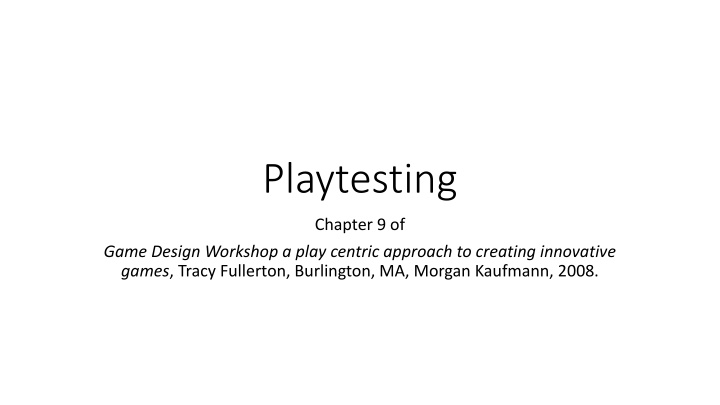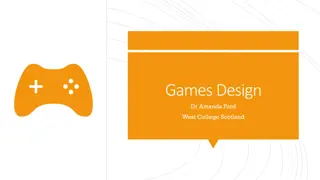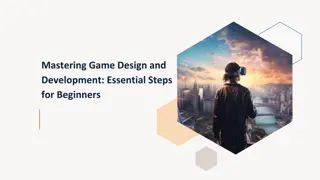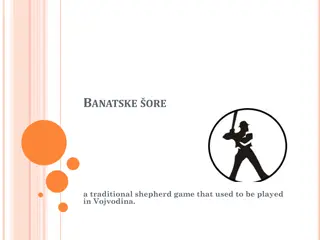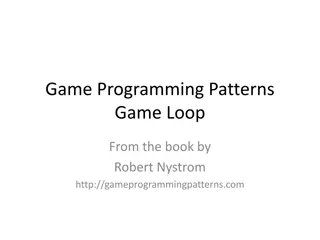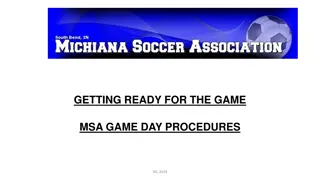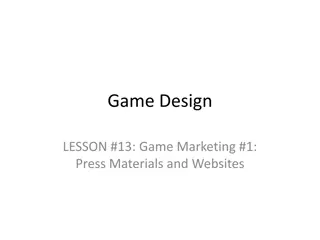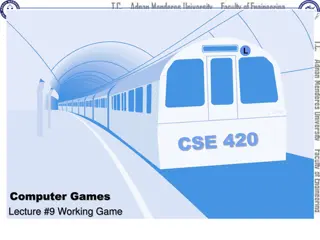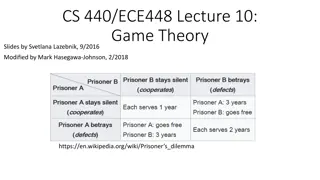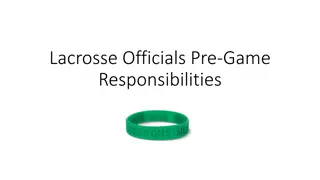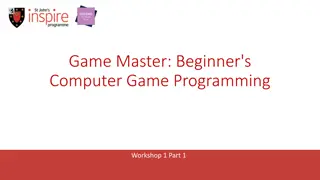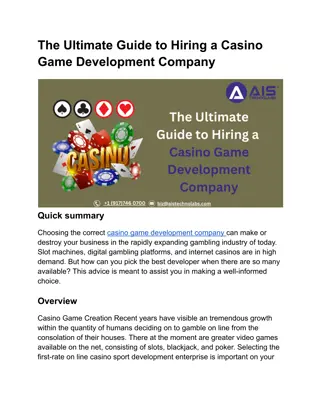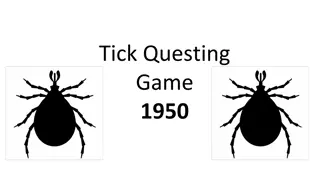Playtesting in Game Design Workshop
Playtesting in game design is crucial for obtaining useful feedback from players, ensuring the game functions as intended, and maintaining balance and fun. Designers must advocate for the user and integrate playtesting tightly into the development process. Recruitment strategies, session considerations, and goals of playtesting are explored, emphasizing the importance of understanding player perspectives and needs. By following a structured playtesting approach, designers can improve the overall gaming experience and prevent the game from straying off course.
Download Presentation

Please find below an Image/Link to download the presentation.
The content on the website is provided AS IS for your information and personal use only. It may not be sold, licensed, or shared on other websites without obtaining consent from the author.If you encounter any issues during the download, it is possible that the publisher has removed the file from their server.
You are allowed to download the files provided on this website for personal or commercial use, subject to the condition that they are used lawfully. All files are the property of their respective owners.
The content on the website is provided AS IS for your information and personal use only. It may not be sold, licensed, or shared on other websites without obtaining consent from the author.
E N D
Presentation Transcript
Playtesting Chapter 9 of Game Design Workshop a play centric approach to creating innovative games, Tracy Fullerton, Burlington, MA, Morgan Kaufmann, 2008.
Involves Selection Recruiting Preparation Controls Analysis
Playtesting is NOT NOT Internal Design Review When design play the game and evaluate This is call internal design review NOT QA Testing for assurance NOT Focus Group Testing marketing execs sitting behind two-way mirrors watching group play and deciding how much to pay for the game NOT Usability Testing: when you analyze how user interface with your interface by tracking their mouse movement or eye movements
Playtseting Goals Useful feedback from players to improve the overall experience of the game Make sure the game is functioning the way you intend. Internally Complete Balance Fun to Play
Playtesting and Interactive Design Designers role: Advocate for the user Keep the players needs and perspective throughout the design and production process Reason for playtesting: Keep the game from straying Playtesting should be tightly integrated in development/production process
Recruitment Self-test is important Confidants: friends and colleague Provide fresh eyes Help them test (early stage can be confusing) When game become playable, move on!! People you don t know Unbiased feedback Find the ideal players Know your target and recruit accordingly
Considerations for a playtest session DO NOT help tester with game play Think what comes in the box (typical instructions/tutorials for players) are fine Think of yourself as an investigator/observer Record what they say, do and analyze their responses Let them make mistakes Best way to learn about your game!! Observe how each person approach the game Are the rules confusing? Let an objective person run the session You be an observe and just observe
A playtest session: plan and stick to the plan Introduction (2-3 minutes): Laying down the ground rules Warm-up Discussion (5 minutes): Assess their background Play session (15-20 minutes) Testing of game not skill No wrong answers Tester should THINK OUT LOUD [Observer should remind them to think aloud] Observe QUIETLY! Discussion of experience (15-20 minutes): Develop set of questions on Overall appeal Interest level Challenge level Understanding of game feature
As developer/designer SHUT UP Learn to listen Avoid being defensive! DO NOT explain what you try to do [they don t need to care] Do NOT lead the tester Make sure you understand what testers are saying It is not what you try to do, it is what the players experience!
Methods of playtesting Group vs One-on-one Group is good for generating ideas, but not as good for evaluating ideas! One-on-One testing: detailed observation Group testing: Group play the game together Observe the group and ask questions as they play Feedback forms: Give each a list of questions Collect both quantitative (numbers, rank) and Qualitative feedbacks (what do you think) Interview One-on-one Open discussion: Group discuss in free-form format Data hook: Collect user movements as a away to understand how user perceive the game
The Play Matrix Ask tester to plot games on this graph Physical Dexterity Chance Skill Mental Calculation
In our case One team at a time Each Game Come to the front: Developer: VERY quickly, show us how to play your games and brief us on what to note Everyone else (remember think out aloud) At least one take notes to post feedback Remember to post your feedback When question, raise your hand and ask Developers pay attention to for questions Walk around to check out how people are playing Take notes!! (on all relevant information) When time s up, we switch team
Implementation Observe classmates play our games Feedback: Considerations for feedback (next slide) Template for feedback (next slide) Mechanics of feedback Post as response to each team EVERY team must provide feedback for every other teams Deadline: Feedback by midnight on the days of the testing
